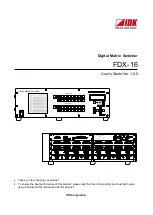
13
MSTP C
ONFIGURATION
MSTP Overview
Spanning tree protocol (STP) cannot enable Ethernet ports to transit their states
rapidly. It costs two times of the forward delay for a port to transit to the forwarding
state even if the port is on a point-to-point link or is an edge port.
Rapid spanning tree protocol (RSTP) supports rapid convergence. However, it suffers
from the same drawback as STP does: all bridges in a LAN share a same spanning tree
and redundant links cannot be blocked in terms of VLANs, making packets of all
VLANs be forwarded along one spanning tree.
Multiple spanning tree protocol (MSTP) can disbranch a looped network to create a
loop-free network of tree topology, and therefore can prevent packets from being
propagated and forwarded endlessly. It also provides multiple redundant paths for
packet forwarding, implementing the forwarding load balancing of VLAN packets.
MSTP is compatible with both STP and RSTP. Moreover, it overcomes the drawbacks
that STP and RSTP suffer from. It allows rapid convergence, and enables packets of
different VLANs to be forwarded along the corresponding paths, and thus provides a
better load balancing mechanism using redundant links.
MSTP Protocol Data Unit
Bridge protocol data unit (BPDU), also known as configuration message, is the
protocol data unit (PDU) that STP uses to determine the topology of a network and to
figure out the spanning trees.
BPDUs fall into the following two categories:
■
Configuration BPDUs: BPDUs of this type are used to maintain the spanning tree
topology.
■
Topology change notification BPDU (TCN BPDN): BPDUs of this type are used to
notify the switches of network changes.
Similar to STP and RSTP, MSTP uses BPDUs to figure out spanning trees. The only
difference is that MSTP BPDUs carry MSTP configuration information of the switches.
Summary of Contents for 5500 SI - Switch - Stackable
Page 24: ...24 ABOUT THIS GUIDE...
Page 50: ...50 CHAPTER 1 GETTING STARTED...
Page 54: ...54 CHAPTER 2 ADDRESS MANAGEMENT CONFIGURATION...
Page 78: ...78 CHAPTER 3 PORT OPERATION...
Page 88: ...88 CHAPTER 4 XRN CONFIGURATION...
Page 122: ...122 CHAPTER 8 VLAN VPN CONFIGURATION...
Page 216: ...216 CHAPTER 15 SSH TERMINAL SERVICES...
Page 268: ...268 CHAPTER 16 IP ROUTING PROTOCOL OPERATION...
Page 308: ...308 CHAPTER 17 NETWORK PROTOCOL OPERATION...
Page 349: ...349...
Page 350: ...350 CHAPTER 18 MULTICAST PROTOCOL...
Page 522: ...522 CHAPTER 22 FILE SYSTEM MANAGEMENT...
Page 584: ...584 CHAPTER 30 PASSWORD CONTROL CONFIGURATION OPERATIONS...
Page 600: ...600 CHAPTER 31 MSDP CONFIGURATION...
Page 614: ...614 CHAPTER 32 CLUSTERING...
Page 670: ...670 CHAPTER C AUTHENTICATING THE SWITCH 5500 WITH CISCO SECURE ACS...
















































